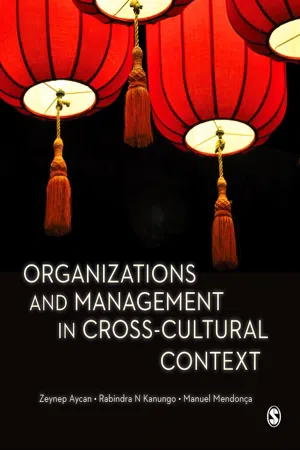Psychology
Motivation Across Cultures
Motivation across cultures refers to the study of how individuals from different cultural backgrounds are driven to achieve their goals and fulfill their needs. It explores the various factors that influence motivation, such as cultural values, beliefs, and social norms. Understanding motivation across cultures is important for developing effective strategies in areas such as education, work, and mental health.
Written by Perlego with AI-assistance
Related key terms
Related key terms
1 of 4
Related key terms
1 of 3
6 Key excerpts on "Motivation Across Cultures"
- Zeynep Aycan, Rabindra N Kanungo, Manuel Mendonca(Authors)
- 2014(Publication Date)
- SAGE Publications Ltd(Publisher)
we are.’Just because getting rich and famous are the motivating forces for some does not mean that they should be the motivating forces for all. In this chapter we will examine motivation through cross-cultural lenses and argue that cultural values, beliefs and norms have an important impact on what motivates employees and how employees are motivated. We will present a review of cross-cultural studies testing the applicability of ‘content’ (examining what motivates employees) and ‘process’ (examining how employees are motivated) theories across cultures.Learning ObjectivesWhat is Employee Motivation? Money was never a big motivation for me, except as a way to keep score. The real excitement is playing the game. Donald Trump• To understand the extent to which and how US-based motivation theories are applicable in different cultural contexts.• To identify the cultural characteristics underlying variations in motivational approaches.• To discover similarities and differences across cultures in the approaches to employee motivation.• To provide guidelines for culturally appropriate methods of motivating employees in diverse work environments.The greater the loyalty of a group toward the group, the greater is the motivation among the members to achieve the goals of the group and the greater the probability that the group will achieve its goals. Rensis LikertMost management literature on motivation is psychologically oriented and is based on psychological models developed and tested almost exclusively in the United States. (Fatehi, 1996, p. 231)The classical definition ofwork motivationis that ‘it is a set of energetic forces that originate both within as well as beyond an individual’s being, to initiate work-related behaviour and to determine its form, direction, intensity and duration’ (Pinder, 1998, p. 11). Traditionally work motivation theories have been categorized as content and process theories. The content theories included in this chapter (i.e., Maslow’s hierarchy of needs, Herzberg’s motivation-hygiene theory, McClelland’s typology of needs) explain work behaviour as the individual’s attempt to satisfy a need. The content theories postulate that when an individual’s need is not met or satisfied then that individual experiences tension which motivates the individual towards a behaviour to satisfy that need. The content theories can be said to answer the ‘what’ of motivation processes, i.e., what needs and in what order do these needs vary in their strength to initiate, energize and sustain the individual’s work behaviour? The process theories, on the other hand, explain work behaviour in terms of the cognitive process which the individual goes through before and during the behaviour. It thus seeeks to identify the process, i.e., ‘how- eBook - ePub
- Bere Mahoney(Author)
- 2011(Publication Date)
- Learning Matters(Publisher)
why we behave as we do is at the heart of individual differences and trait psychology. One consequence of this is that the topic of human motivation is traditionally considered in undergraduate courses on individual differences, and rightly so. However, this can entail dealing with the topic towards the end of the text and implicitly rather than explicitly linking it to individual differences psychology. In these circumstances the student can be left to work out for themselves where motivation research fits into the complex landscape of individual differences. Given the sheer breadth and depth of research on both motivation and individual differences in general, this can be unhelpful and leave the student with a daunting analytical task. Here, we also cover the topic of human motivation towards the end of the book. However, an attempt will be made to explain this placing, and we will also attempt to consider the links between personality and motivation research.To try to achieve these challenging goals, we will consider the three questions listed above. Motivation research has tended to take a particular approach to the first two generic questions. To consider this particular approach, you will – as we have done with other topics – first examine definitions and conceptualisations of the term motivation. What is meant by the term? How have different fields within psychology approached this construct? The broader context of motivation research is important here. Conceptual shifts have taken place in this research over the past 100 years. Importantly, there has been a conceptual shift as top-down approaches have been supplanted by more bottom-up approaches to motivation; in this chapter you will be encouraged to consider the extent of this shift (Caprara and Cervone, 2000 ). Another feature of this shift is that currently there appears to be a degree of consensus among psychologists about the nature of human motivation; in this chapter you will be encouraged to think critically about the extent of this theoretical consensus. Towards the end of the chapter we will consider how motivation research and individual differences psychology are linked. This is not a straightforward issue despite the fact that some researchers state that motivation and personality processes are the same or at least closely linked (Caprara and Cervone, 2000 ). In some instances this statement is not explained. Sometimes it is assumed that students can work out the links for themselves, or that stating that individuals differ in their motivation - eBook - ePub
- Andrew J. Elliot, Andrew J. Elliot(Authors)
- 2013(Publication Date)
- Psychology Press(Publisher)
However, it is important to underscore that these cultural differences do not suggest that either type of motivation is absent across cultures. Indeed, the distinction between approach and avoidance motivation is evident across species, even for the most basic organisms (e.g., amoebas), underscoring the fundamental role both modes of motivation play for many, if not all, living organisms (Elliot, 1999). It seems reasonable to assume that the two modes of motivation are functional universals, or mental process that universally serve the same function, although their accessibility may differ importantly across cultures (Norenzayan & Heine, 2005). To the extent that approach–avoidance motivation is universally available, it suggests that observed cultural differences could be reduced or even reversed with appropriate experimental manipulations. Cross-cultural studies that investigate how the correlates of approach and avoidance motivation are influenced by various manipulations are critical for identifying the mechanisms that underlie these motivations. This is one way that cultural variation can be used to inform the nature of universal theories: it serves to spotlight where one should more effectively target the search for mechanisms. Whatever variables underlie observed cultural differences in motivations likely play a key role in the manifestation of the motivations in other contexts as well. For example, one way to consider why East Asian and Western cultures differ in their reliance on approach and avoidance motivation is to explore another variable for which East Asians and Westerners have been shown to reliably differ: lay theories of achievement (Dweck & Leggett, 1988). Many studies have found evidence for heightened entity theories of achie vement among Westerners compared with East Asians (Norenzayan, Choi, & Nisbett, 2002 ; Stevenson & Stigler, 1992) - eBook - ePub
- Graham C. Davey, Graham C. Davey(Authors)
- 2018(Publication Date)
- Wiley(Publisher)
The culture we are bought up in has long been thought to influence how motivated we feel to achieve. For example, most cultures can be divided into collectivist or individualistic types, and these different types can significantly influence how important we believe achievement to be, as well as influencing how social relationships affect our motivation to achieve (Trumbull & Rothstein-Fisch, 2011). In particular, collectivist cultures (such as many Asian cultures) tend to influence individuals to view achievement as something that should be accomplished in cooperative groups, while individualistic cultures (such as Western European and North American cultures) place great emphasis on individual achievements.SECTION SUMMARY
- We are motivated to be socially involved with others and to be seen as able to achieve by others.
- All of us are part of multiple social groups, and humans are biologically programmed to form social relationships.
- Social relationships can benefit not only our emotional health but also our physical health.
- In this increasingly technological era, even virtual social support could be beneficial for us.
- Achievement motivation is the drive that people feel to succeed.
- Self-determination theory states that we all require competence, autonomy, and relatedness to feel intrinsically motivated and to experience well-being.
- Our ability to delay gratification, even at a young age, can have a number of important influences on what we achieve over the course of our lifetime.
- Most cultures can be divided into collectivist or individualistic types, and these different types can significantly influence how important we believe achievement to be, as well as influencing how social relationships affect our motivation to achieve.
APPLICATIONS OF THEORIES OF MOTIVATION
LEARNING OBJECTIVE 5.6
Describe the ways in which theories of motivation can be used in everyday situations.We have learned about several theories of motivation and reviewed research into motivation. We are now going to draw this knowledge together and think about how we can apply it in several everyday situations. - Betty Jane Punnett(Author)
- 2018(Publication Date)
- Routledge(Publisher)
Chapter 7Motivation and Organizational Behavior in an International Context
LEARNING OBJECTIVES
The purpose of this chapter is to consider motivation and how it may differ from one location to another. Specifically, the chapter will:- • Define and discuss the broad concept of motivation;
- • Explain why it is difficult to understand what motivates people, especially in different contexts;
- • Introduce and explain the major western theories of motivation;
- • Consider needs, equity, rewards, expectations, goals, and delegation/participation and how they relate to motivation;
- • Examine each of the motivation theories in the context of differences around the world, including cultural differences, and the impact of millennials at work;
- • Explore the aspects of motivation theories that seem to be universal as well as those that seem to be culturally contingent;
- • Make suggestions about how managers can assess and address motivation in different contexts.
Introduction
Motivation refers to the inner urges that cause people to behave in certain ways rather than the behavior itself. In the workplace, we talk of people being highly motivated when they work hard to accomplish objectives that are consistent with the organization’s goals. In this case, we observe the behavior, but we cannot observe the cause(s) of the behavior. We talk of people being de-motivated on the job when they seem disinterested and need to be pushed to perform. What makes people motivated or de-motivated at work is complex because motivation is caused by a mix of psychological (e.g., introversion/extroversion, self-esteem) and demographic (e.g., age, gender, ethnicity) characteristics.It is not really accurate to talk of people being de-motivated. People are always motivated in some direction; the question is the direction of their motivation. When someone is de-motivated at work, it means that they are motivated in some non-work direction; that is, they would rather be doing something other than work. Nevertheless, the terminology of de-motivation is used frequently in everyday language, so it will be used in this chapter. When we say that someone is de-motivated, then, we mean that they are not working very hard, and their performance is less than could be expected. This is why motivation and its causes are of such interest to managers. A firm’s success and profitability are directly related, to a large extent, to the performance and productivity of the people who work for the firm; thus, a major component of a manager’s role is to ensure that employees are performing at a peak level.- Betina Szkudlarek, Laurence Romani, Dan V. Caprar, Joyce S. Osland, Betina Szkudlarek, Laurence Romani, Dan V. Caprar, Joyce S. Osland(Authors)
- 2020(Publication Date)
- SAGE Publications Ltd(Publisher)
In this regard, Cascio (2012) provides considerable guidance to methodological challenges inherent in behavioral research in general. He explores five methodological issues, including translation, conceptual, functional, and metric equivalence when assessment or survey questions are used in different languages and cultural contexts; the use of multiple, overlapping constructs and common methods bias; limitations of measures of internal-consistency reliability (coefficient alpha); sampling strategies; and non-response bias. The article defines each issue, identifies the implications of failure to address it, and suggests alternative strategies to ensure valid inferences.Conclusion: Moving Forward
During the past several years, we have witnessed some progress on the topic of cross-cultural work motivation. However, despite this progress, we are left with the conclusion that serious efforts are still required to build on these current findings in an effort to extrapolate more of the essence of culture as a predictive study variable in work motivation theory and research. We seem to remain largely mired in the realm of trying to understand what and how. What would be particularly useful at this point would be expanding our understanding of why. So, where do we go from here?Obviously, a first step here is to address the theoretical and methodological limitations and omissions noted above. The field deserves more rigorous theory-based research. Exploring the role of unconscious behavior in employee motivation is an important challenge in this regard. Taking a different approach, Jonsen (2018) recently advocated for researchers to maintain and preserve their status as subjective thinkers, with time to think. This could help end ‘static nation-state thinking’ and move to a different, multidisciplinary, and more dynamic set of assumptions, approaches, and research questions underlying cross-cultural research.In addition, increased efforts to create multicultural and multidisciplinary research teams would further not just access to more diverse samples but also more thorough explorations of the reasons behind the findings that emerge. Improved sampling and better designed and validated research instruments would complete this package of recommendation.There are several ways to pursue this. Latham (2012) suggests the need to build a boundaryless psychology that integrates the findings from social psychology, clinical psychology, evolutionary psychology, and neuroscience. Experts on human resource management, industrial organization, and organizational behavior should contribute to this effort in creating a vision of people that is broad and not reductive, integrated and not fragmented, in its dealing with the whole person, both conventionally and across cultures.
Index pages curate the most relevant extracts from our library of academic textbooks. They’ve been created using an in-house natural language model (NLM), each adding context and meaning to key research topics.
Explore more topic indexes
Explore more topic indexes
1 of 6
Explore more topic indexes
1 of 4





